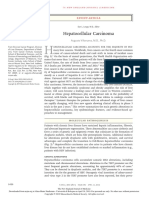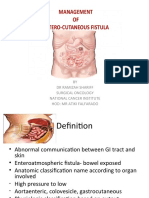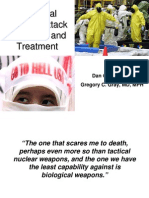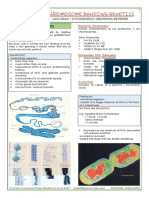0 ratings0% found this document useful (0 votes)
139 viewsProstatitis AUA 2017
Prostatitis AUA 2017
Uploaded by
Andres Felipe Cordoba AriasThe document provides information on prostatitis, including:
1) It defines the different types of prostatitis such as acute bacterial, chronic bacterial, non-bacterial, and prostatodynia.
2) Treatment options discussed include antibiotics, alpha-blockers, anti-inflammatories, 5-alpha-reductase inhibitors, physical therapy, and prostate massage.
3) The epidemiology, clinical presentation, etiology, classification systems such as the NIH categories, and evaluation including history, exam findings, and testing are outlined.
Copyright:
© All Rights Reserved
Available Formats
Download as PPTX, PDF, TXT or read online from Scribd
Prostatitis AUA 2017
Prostatitis AUA 2017
Uploaded by
Andres Felipe Cordoba Arias0 ratings0% found this document useful (0 votes)
139 views29 pagesThe document provides information on prostatitis, including:
1) It defines the different types of prostatitis such as acute bacterial, chronic bacterial, non-bacterial, and prostatodynia.
2) Treatment options discussed include antibiotics, alpha-blockers, anti-inflammatories, 5-alpha-reductase inhibitors, physical therapy, and prostate massage.
3) The epidemiology, clinical presentation, etiology, classification systems such as the NIH categories, and evaluation including history, exam findings, and testing are outlined.
Original Description:
prostatitis guia AUA 2017
Copyright
© © All Rights Reserved
Available Formats
PPTX, PDF, TXT or read online from Scribd
Share this document
Did you find this document useful?
Is this content inappropriate?
The document provides information on prostatitis, including:
1) It defines the different types of prostatitis such as acute bacterial, chronic bacterial, non-bacterial, and prostatodynia.
2) Treatment options discussed include antibiotics, alpha-blockers, anti-inflammatories, 5-alpha-reductase inhibitors, physical therapy, and prostate massage.
3) The epidemiology, clinical presentation, etiology, classification systems such as the NIH categories, and evaluation including history, exam findings, and testing are outlined.
Copyright:
© All Rights Reserved
Available Formats
Download as PPTX, PDF, TXT or read online from Scribd
Download as pptx, pdf, or txt
0 ratings0% found this document useful (0 votes)
139 views29 pagesProstatitis AUA 2017
Prostatitis AUA 2017
Uploaded by
Andres Felipe Cordoba AriasThe document provides information on prostatitis, including:
1) It defines the different types of prostatitis such as acute bacterial, chronic bacterial, non-bacterial, and prostatodynia.
2) Treatment options discussed include antibiotics, alpha-blockers, anti-inflammatories, 5-alpha-reductase inhibitors, physical therapy, and prostate massage.
3) The epidemiology, clinical presentation, etiology, classification systems such as the NIH categories, and evaluation including history, exam findings, and testing are outlined.
Copyright:
© All Rights Reserved
Available Formats
Download as PPTX, PDF, TXT or read online from Scribd
Download as pptx, pdf, or txt
You are on page 1of 29
Created: September 11, 2017
AUA Core Curriculum
Prostatitis
Introduction
• Very common in clinical practice
• Can be life threatening
• Acute vs. Chronic
• Bacterial vs. Abacterial
• Other syndromes and symptoms
Epidemiology
• Most common urologic diagnosis in men <50
• 3rd most common urologic diagnosis in men >50
• 5% of men aged 20-50 have a history of prostatitis
• Prevalence can vary by world region
• 12.2% in Nigeria
• 8% in Malaysia
• 6.6% in Canada
• 2.7% in Singapore
Definitions/Classification
• Traditional = Meares and Stamey in 1968
– four-glass test
• Acute bacterial prostatitis
• Chronic bacterial prostatitis
• Non-bacterial prostatitis
• Prostatodynia (prostatic pain)
4 Glass Test
Acute vs. Chronic bacterial prostatitis
• Acute
– Fevers, Chills, Sepsis
– Luekocytes in the prostatic fluid
• Chronic
– Luekocytes in the prostatic fluid only
– Positive cultures for bacteria
Abacterial vs. Prostodynia
• Abacterial
– Luekocytes in the prostatic fluid
– Negative culture
• Prostodynia
– No leukocytes
– No bacteria
NIH Classification
• Category I – Identical to acute bacterial prostatitis
• Category II – Identical to chronic bacterial prostatitis
• Category III Chronic Pelvic Pain Syndrome (CPPS) –GU pain, no bacteria
• Category IIIA (Inflammatory CPPS) – Excessive WBC in EPS
• Category IIIB (Non-inflammatory CPPS) – No significant WBC
• Category IV (Asymptomatic Inflammatory) –WBC or bacteria, no symptoms
Clinical Presentation: History
• Pain = Location, Frequency, Quality
– Pain with urination or ejaculation
• Urination = Incomplete emptying/Frequency
• Impact: changes behavior, occupies thoughts
• Quality of Life
NIH-Chronic Prostatitis Symptom Index
(NIH-CPSI)
Clinical Presentation: History
• Sexually transmitted infection history
• Recent new contacts
• Recent hospitalization (i.e. catheterization)
• Recent urologic procedures
• BCG, Exposure to Tuberculosis
UPOINT
• Phenotypic classification
– Urinary
– Psychosocial
– Organ specific
– Infection
– Neurologic/systemic
– Tenderness of skeletal muscles
Clinical Presentation: Exam
• Dominated by pain
– suprapubic pain – difficulty urinating
– testicular pain – dysuria
– penile pain – painful ejaculation
– urethral pain – perineal pain
Clinical Presentation: Exam
• Digital rectal exam
• tender and boggy
• warm prostate in acute prostatitis
• tender prostate in chronic prostatitis.
• no need for expression of prostatic fluid in ACUTE phase
• risk that an aggressive prostate exam may cause sepsis
• Urinalysis and urine culture
• PSA is not necessary
Clinical Presentation: Exam
4 Glass
Prostate Message
VB= voided bladder urine
Clinical Presentation: Exam
2 Glass
Prostate Message
Nickel et al.
demonstrated 2
Glass Test had a
91% sensitivity
and specificity
compared with
the traditional
Meares-Stamey
test
Etiology
• Microbial
Etiology
• E. coli 65-80%
• Host Defense –
• Intraprostatic ductal reflux of urine
• Phimosis
• Indwelling Foley catheter
• Transurethral Surgery
• Dysfunctional Voiding
• high pressure voiding
• Bladder neck hypertrophy
Treatment
• Antibiotics
• Alpha-blockers
• Anti-inflammatories
• 5-alpha-reductase inhibitors
• Physical therapy
• Prostate massage
• Frequent ejaculation
• Surgery
Antibiotics
• Bactrim (TMP-SMX)
– most commonly used antibiotic in the 70’s to 90’s
– efficacy rates of 30-50%
– treatment courses reaching up to 90 days
• Fluoroquinolones
– more efficacious and require shorter durations of therapy
– 57-77% cure rates
– Treat 4-6 weeks if pretreatment cultures are positive
Alpha Blockers
• Bladder neck and prostate are rich in alpha-adrenergic receptors
• Relaxation via alpha-adrenergic blockade may improve outflow
• improving urinary flow and decreasing intra-prostatic ductal reflux
• Clinical Trial (Nickel et al. 2008)
– Men with chronic prostatitis and alpha blocker naive
– Treated with alfuzosin vs. placebo x 12 weeks
– No significant difference in resolution rates
Anti-Inflammatory
• Non-steroidal anti-inflammatories
• Corticosteroids
• Immunosuppressive drugs
• Clinical Trial
– Dimitrakov in 2004
– high dose methylprednisolone followed by rapid tapering
– Vs. Placebo
– May have more efficacy than placebo even after 12 months
– side effect profile was deemed to be moderately severe
Hormonal
• 5 alpha-reductase inhibitors
• Multiple studies have shown reductions in
prostatitis and BPH symptom scores.
– long-term dutasteride therapy
• improvement in prostatitis related symptoms
• older men with an increased PSA and BPH
Physical Therapy, Prostate Massage, and
Alternative Medicine
• Physical therapy
– Reduce Stress and overall pain symptoms
• Prostate Message
– 10-minute prostate exam 3 times per week
• Alternative Medicine
– Acupuncture (Lee et al in 2008) = small improvement
– Myofacial Trigger point message
References
You might also like
- Ureteral Stent Sympton Questionnaire (English)Document5 pagesUreteral Stent Sympton Questionnaire (English)cateterdoblejotaNo ratings yet
- Expanding Selection Criteria For Living Liver DonorDocument123 pagesExpanding Selection Criteria For Living Liver DonortasarimkutusuNo ratings yet
- 339 MPHEL729 NorthBristolJDFINAL PAEDIATRICANDPERINATALPATHOLOGIST PDFDocument24 pages339 MPHEL729 NorthBristolJDFINAL PAEDIATRICANDPERINATALPATHOLOGIST PDFMD Luthfy LubisNo ratings yet
- Acute Appendicitis: Complications & TreatmentDocument28 pagesAcute Appendicitis: Complications & Treatmentsimi yNo ratings yet
- Prescribing Regimens of Feeding JejunostomyDocument28 pagesPrescribing Regimens of Feeding JejunostomyRajarshi KumarNo ratings yet
- Page 3Document1 pagePage 3Lexi Marlena AlvidrezNo ratings yet
- Prostate CancerDocument254 pagesProstate CancertamikanjiNo ratings yet
- Johansen - The Role of Fosfomycin As Prophylaxis - 20.07.2023Document80 pagesJohansen - The Role of Fosfomycin As Prophylaxis - 20.07.2023Edwin MontañezNo ratings yet
- (Landes Bioscience Medical Handbook Vademecum) Daniel Nachtsheim - Urological Oncology (2005, Landes Bioscience, Inc.) PDFDocument147 pages(Landes Bioscience Medical Handbook Vademecum) Daniel Nachtsheim - Urological Oncology (2005, Landes Bioscience, Inc.) PDFPavan JonnadaNo ratings yet
- Bladder Cancer 7Document44 pagesBladder Cancer 7Awais Ayub100% (1)
- Lower Urinary Tract Symptoms (LUTS)Document26 pagesLower Urinary Tract Symptoms (LUTS)Ayi Abdul BasithNo ratings yet
- Bladder Cancer 6Document26 pagesBladder Cancer 6Awais Ayub100% (1)
- EAUN15 Guideline Intravesical InstillationDocument90 pagesEAUN15 Guideline Intravesical InstillationRafael RojasNo ratings yet
- Neo BladderDocument32 pagesNeo Bladderbelieveme030589No ratings yet
- CA Canal AnalDocument12 pagesCA Canal AnalGabriela Zavaleta CamachoNo ratings yet
- Basic Principles in Surgical Oncology - Cady1997 Arch Surg PDFDocument9 pagesBasic Principles in Surgical Oncology - Cady1997 Arch Surg PDFDiego EskinaziNo ratings yet
- Vascular Presentation - Visceral Artery Aneurysms - MCGDocument22 pagesVascular Presentation - Visceral Artery Aneurysms - MCGYasir BouchiNo ratings yet
- Total Pelvic ExenterationDocument13 pagesTotal Pelvic ExenterationRirin Wahyuni100% (1)
- Hepatocellular Carcinoma: Review ArticleDocument13 pagesHepatocellular Carcinoma: Review ArticleAnnagiulia Gramenzi100% (2)
- Enterocutaneous Fistula ManagementDocument59 pagesEnterocutaneous Fistula ManagementAbu JamalNo ratings yet
- Bethesda ScoreDocument7 pagesBethesda ScoreTiberiu BircaNo ratings yet
- Remote and Rural SurgeryDocument12 pagesRemote and Rural SurgeryUday Prabhu100% (1)
- Pathology of The AdnexaDocument59 pagesPathology of The AdnexaArnella HutagalungNo ratings yet
- Prodige 23Document14 pagesProdige 23josebaNo ratings yet
- Comparison of Serum Microseminoprotein-Beta (MSMB) With Total Prostate Specific Antigen (TPSA) in The Diagnosis of Prostate Cancer in African MenDocument7 pagesComparison of Serum Microseminoprotein-Beta (MSMB) With Total Prostate Specific Antigen (TPSA) in The Diagnosis of Prostate Cancer in African MenInternational Journal of Innovative Science and Research TechnologyNo ratings yet
- Bladder Cancer LancetDocument11 pagesBladder Cancer LancetYesenia HuertaNo ratings yet
- Management of End-Stage Liver DiseaseDocument34 pagesManagement of End-Stage Liver DiseaseAldo IbarraNo ratings yet
- 2018 Edition of The European Association of Urology (EAU) GuidelinesDocument415 pages2018 Edition of The European Association of Urology (EAU) Guidelinessiraj hadi93% (15)
- My Revision Timetable 2023Document10 pagesMy Revision Timetable 2023Ebraheam HadiNo ratings yet
- General Surgery Topic List 2016Document2 pagesGeneral Surgery Topic List 2016anabanananNo ratings yet
- Landes Bioscience Musculoskeletal Procedures Diagnostic and Therapeutic Jun 2003 PDFDocument231 pagesLandes Bioscience Musculoskeletal Procedures Diagnostic and Therapeutic Jun 2003 PDFsun sealNo ratings yet
- Urology SummaryDocument33 pagesUrology Summarylalo5eerNo ratings yet
- IEC-Atlas of Endoscopic UltrasoundDocument12 pagesIEC-Atlas of Endoscopic UltrasoundDannyNo ratings yet
- Choledocal CystDocument11 pagesCholedocal CystBilly JonatanNo ratings yet
- Bariatric SurgeryDocument72 pagesBariatric Surgerysavvy_as_98No ratings yet
- Bladder Substitution and Urinary DiversionDocument58 pagesBladder Substitution and Urinary DiversionlifespotNo ratings yet
- 4 5854781980616429092Document422 pages4 5854781980616429092Muhammad Ahmad bin makruf syammakuNo ratings yet
- Schwartz2002 PDFDocument7 pagesSchwartz2002 PDFnova sorayaNo ratings yet
- Laparoscopy: Shenillee Burgess Reyad HoseinDocument31 pagesLaparoscopy: Shenillee Burgess Reyad HoseinShenillee BurgessNo ratings yet
- Robot-Assisted Laparoscopic Extravesical Ureteral Reimplantation - Technique Modifications Contribute To Optimized OutcomesDocument6 pagesRobot-Assisted Laparoscopic Extravesical Ureteral Reimplantation - Technique Modifications Contribute To Optimized OutcomesJulio GomezNo ratings yet
- Surgical Endoscopy Journal 1Document86 pagesSurgical Endoscopy Journal 1Saibo BoldsaikhanNo ratings yet
- 2018 ESC Guidelines For The Management of Cardiovascular Disease in PregnancyDocument84 pages2018 ESC Guidelines For The Management of Cardiovascular Disease in Pregnancyasm obginNo ratings yet
- Thyroid NodulesDocument34 pagesThyroid NodulesEphobiaNo ratings yet
- Prostate Biopsy - The Transperineal ApproachDocument9 pagesProstate Biopsy - The Transperineal ApproachRanda HalfianNo ratings yet
- Post Radical Prostatectomy Penile Rehabilitation - AUA Update Series 2008Document8 pagesPost Radical Prostatectomy Penile Rehabilitation - AUA Update Series 2008Kevin ZornNo ratings yet
- Uterine Myoma - Surgical or Medical1.original.15615304794199696230846510162Document42 pagesUterine Myoma - Surgical or Medical1.original.15615304794199696230846510162Mi MaymdNo ratings yet
- Gui322cpg1504e2 PDFDocument15 pagesGui322cpg1504e2 PDFieo100% (1)
- A.Valeri Et Al - Surgery of The Adrenal Gland - 2013Document200 pagesA.Valeri Et Al - Surgery of The Adrenal Gland - 2013Sergiu FedoretNo ratings yet
- AAES Guidelines Thyroid PDFDocument73 pagesAAES Guidelines Thyroid PDFDana ChernovNo ratings yet
- Surgical Principles of Rectal CancerDocument15 pagesSurgical Principles of Rectal CancerashentaxpayeeNo ratings yet
- Robert J. Snyder, DPM, MSC, Cws Professor and Director of Clinical Research Barry University SPMDocument108 pagesRobert J. Snyder, DPM, MSC, Cws Professor and Director of Clinical Research Barry University SPMddNo ratings yet
- Metastatic CADocument58 pagesMetastatic CAbeosroNo ratings yet
- EAU Guidelines On Non Muscle Invasive Bladder Cancer 2023 - 2023 03 10 101110 - JuedDocument66 pagesEAU Guidelines On Non Muscle Invasive Bladder Cancer 2023 - 2023 03 10 101110 - JuedMiguel JiménezNo ratings yet
- Full Download Campbell Walsh Wein Urology 12th Edition Alan W Partin PDFDocument64 pagesFull Download Campbell Walsh Wein Urology 12th Edition Alan W Partin PDFboggilenoj100% (5)
- Transverse Cerebellar Measurement Fetal AgeDocument96 pagesTransverse Cerebellar Measurement Fetal Ageparas yadav100% (1)
- Locally Advanced Breast CarcinomaDocument31 pagesLocally Advanced Breast Carcinomaapi-3701915100% (1)
- VA SICU Guide To An Organ Based PresentationDocument4 pagesVA SICU Guide To An Organ Based Presentationseigfried13No ratings yet
- Arterial and Venous Access in the Cardiac Catheterization Lab: Arterial and Venous Access in the Cardiac Catheterization LabFrom EverandArterial and Venous Access in the Cardiac Catheterization Lab: Arterial and Venous Access in the Cardiac Catheterization LabMazen Abu-FadelNo ratings yet
- Surgical Principles in Inguinal Hernia Repair: A Comprehensive Guide to Anatomy and Operative TechniquesFrom EverandSurgical Principles in Inguinal Hernia Repair: A Comprehensive Guide to Anatomy and Operative TechniquesMelissa Phillips LaPinskaNo ratings yet
- Mtap BB 1Document23 pagesMtap BB 1Jennie Grace MaloomNo ratings yet
- Gene Fine Structure Analysis in Prokaryotes and VirusesDocument32 pagesGene Fine Structure Analysis in Prokaryotes and Viruseserica williamsNo ratings yet
- SparganosisDocument21 pagesSparganosisJose Ho100% (1)
- Atrofi MukosaDocument59 pagesAtrofi MukosaFaiza LailiyahNo ratings yet
- Research DesignDocument29 pagesResearch DesignSean Mclean100% (1)
- Hepatitis B Immunisation ForDocument89 pagesHepatitis B Immunisation ForNacko StavreskiNo ratings yet
- 4 LevelsDocument2 pages4 Levelspeter911cm100% (4)
- CCHF in IraqDocument4 pagesCCHF in IraqRasoulNo ratings yet
- Biological Warfare Attack, Diagnosis, TreatmentDocument41 pagesBiological Warfare Attack, Diagnosis, Treatmentapi-3695725No ratings yet
- FHC AaaaAAADocument5 pagesFHC AaaaAAAJUANJOSEFOXNo ratings yet
- AmikinDocument2 pagesAmikinLIEZEL GRACE VELAYONo ratings yet
- Basic Immunologic Procedures Part 5 Agglutination: Terry Kotrla, MS, MT (ASCP) BBDocument27 pagesBasic Immunologic Procedures Part 5 Agglutination: Terry Kotrla, MS, MT (ASCP) BBAlina Mihaela MarianNo ratings yet
- Get The Facts About Tuberculosis DiseaseDocument16 pagesGet The Facts About Tuberculosis Diseasedjprh tbdotsNo ratings yet
- Symptoms of Paget S DiseaseDocument49 pagesSymptoms of Paget S DiseaseurufahoNo ratings yet
- Everything You Need To Know About Dengue FeverDocument10 pagesEverything You Need To Know About Dengue FeverJi AhNo ratings yet
- Case Summary 14 - Necrotizing FasciitisDocument12 pagesCase Summary 14 - Necrotizing FasciitisIndra Purwanto AkbarNo ratings yet
- Parasitology TablesDocument63 pagesParasitology TablesاناكافرNo ratings yet
- Norovirus Fact SheetDocument1 pageNorovirus Fact SheetovwebmasterNo ratings yet
- pLICO VectorsDocument2 pagespLICO VectorsAlleleBiotechNo ratings yet
- Guide To The Requirements of The Arizona School Immunization LawDocument2 pagesGuide To The Requirements of The Arizona School Immunization LawAndres Sotil FalconNo ratings yet
- Some in Vitro Observations On The Biological Control of Sclerotium Rolfsii, A Serious Pathogen of Various Agricultural Crop PlantsDocument8 pagesSome in Vitro Observations On The Biological Control of Sclerotium Rolfsii, A Serious Pathogen of Various Agricultural Crop PlantsInternational Organization of Scientific Research (IOSR)No ratings yet
- HIV - Aids Lecture DR Nabil.1Document25 pagesHIV - Aids Lecture DR Nabil.1Hannan AliNo ratings yet
- Cod 2008 Sources MethodsDocument28 pagesCod 2008 Sources MethodsOval Kinh CanNo ratings yet
- Chickenpox: (Varicella)Document10 pagesChickenpox: (Varicella)Nessa Layos MorilloNo ratings yet
- Kelly 2005 British Journal of Oral and Maxillofacial SurgeryDocument1 pageKelly 2005 British Journal of Oral and Maxillofacial SurgerylalajanNo ratings yet
- Cytogenetics SemiFinal L TRANSESDocument15 pagesCytogenetics SemiFinal L TRANSESQUEEN NICOLE O. MACALAMNo ratings yet
- Staphylococcus and MicrococcusDocument4 pagesStaphylococcus and MicrococcusAmador GielasNo ratings yet
- Virulence FactorsDocument49 pagesVirulence FactorsHira PanhwerNo ratings yet
- Group 1 - HIV - Case StudyDocument30 pagesGroup 1 - HIV - Case StudyCONTRERAS, ALIANNA IRISHNo ratings yet

























































































